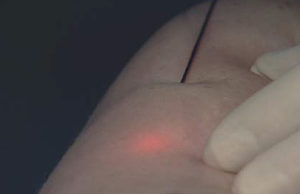Smartlipo, otherwise known as laser lipolysis or laser-assisted lipolysis, is a new method of liposuction using laser technology. In traditional liposuction, significant force to disrupt the tissue that holds the fat together is needed to free it up. Almost everyone has seen on TV or videos of how the procedure is performed and few would doubt that the traditional approach is fairly traumatic. Effective, but traumatic. With Smartlipo, the required mechanical force is reduced by the heating or melting of the fat.
Fat is a unique tissue in that it is really globs of lipid (triglycerides) surrounded and encased in strands of connective tissue. To no surprise, fat has a fair amount of water in it which is very relevant in laser liposuction but largely unimportant in traditional liposuction. Fat is roughly 25% water. Running through the fat are small blood vessels and lymphatic channels. Some fat areas have globules that are quite big (‘buttery fat”) and other fat areas have smaller globules with a lot of connective tissue. (‘gritty fat’) Gritty fat, such as in the upper abdomen or back, takes a lot more force to break it up and be suctioned out.

There is currently much debate as to the ‘ideal’ laser wavelength for which to use to create this fat melting effect. Most of laser technology is based on matching the wavelength to the chromophobe (color) of the target tissue. Fat is a weak target because its yellow color, being lighter, is not a great absorber of wavelength energy. (same problem with the yellow and lighter colors in tattoo removal) Some manufacturers use 1064nm while others use 924nm which is theoretically more specific for lipid absorption. Both cause substantial heat generation and the general effect of heat transmission to the fat cell is probably achieved equally by both. Dual laser wavelengths today have become the new standard in an effort to target the water in the dermis (skin) as well. These include wavelengths such as 975 and 1320nms.
The sophistication of laser-assisted lipolysis is rapidly expanding. Dual wavelength energy delivery, monitoring internal temperature levels, and greater surgical finesse is rapidly changing the way liposuction is being performed. Better results and less recovery appear to be more than just marketing hype with this new laser-assisted liposuction technology.
Dr. Barry Eppley
Indianapolis, Indiana


